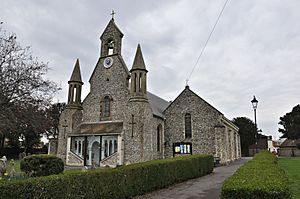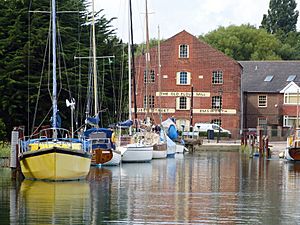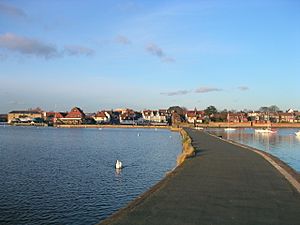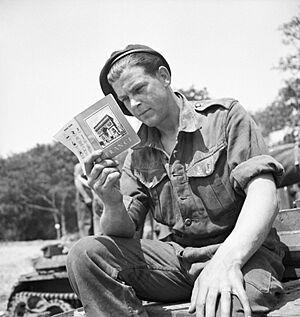Emsworth facts for kids
Quick facts for kids Emsworth |
|
|---|---|
 |
|
| Population | 10,269 |
| OS grid reference | SU748060 |
| Civil parish |
|
| District |
|
| Shire county | |
| Region | |
| Country | England |
| Sovereign state | United Kingdom |
| Post town | EMSWORTH |
| Postcode district | PO10 |
| Dialling code | 01243 |
| Police | Hampshire |
| Fire | Hampshire |
| Ambulance | South Central |
| EU Parliament | South East England |
| UK Parliament |
|
Emsworth is a lovely town located on the south coast of England. It is part of the Borough of Havant in the county of Hampshire. The town sits at the top of an arm of Chichester Harbour, which is a large, shallow bay connected to the English Channel. Emsworth is about halfway between the cities of Portsmouth and Chichester.
In 2021, Emsworth had a population of 10,269 people. The town has a special basin for yachts and fishing boats. This basin fills up when the tide is high and can be emptied through a gate (called a sluice) when the tide is low. Emsworth is also part of a larger built-up area that includes nearby villages like Westbourne and Southbourne. This whole area had a population of 18,777 people in 2011.
Contents
What Does the Name Emsworth Mean?
The name Emsworth comes from an old English word, Æmelswrð. This word means 'Æmmele's curtilage'. A curtilage was like a fenced-in yard or area around a house. So, it means the property owned by someone named Æmmele. Another idea is that it came from Amils worth, where worth also means a fence around property.
Many people think Emsworth got its name from the River Ems. However, this is not true! Before the 1500s, the river was actually called the Bourne. A writer named Raphael Holinshed renamed the river in the 16th century. He wrote that the Emille river flows into the sea at Emilswort or Emmesworth. This means the river was named after the town, not the other way around.
A Look at Emsworth's History
How Old is Emsworth?
Emsworth has a very long history, going back thousands of years! In ancient times, the River Ems was tidal much further inland. This meant Emsworth was almost like an island at high tide. People used a coastal path that went through the area. This path likely went around the edges of the various creeks that led into the harbour.
Roman Times in Emsworth
During the time of the Roman Empire, a large Roman villa stood south of the main road. This villa was a big building made of brick and stone. It had floors paved with red brick and colorful stone. From the villa, people could see the harbour and the wooded shores of Hayling Island. The land around Emsworth has been farmed for a very long time, perhaps 1,500 to 1,800 years.
Anglo-Saxon Settlements
After the year 500 AD, people called Saxons started to settle in the area. Kings Æthelstan and Æthelred gave special documents (charters) in 935 AD and 980 AD. These documents set and confirmed the borders of the Warblington area. From 980 AD to 1066 AD, a powerful family, including Godwin, Earl of Wessex and his son Harold Godwinson, owned the land.
Medieval Emsworth
After the Norman Conquest in 1066, the land around Warblington was given to Roger de Montgomery. The Domesday Book, a famous survey from that time, mentions the area. It listed two churches, a mill, 29 families, and two slaves. This meant about 120 people lived there. There were also seven plough teams, showing that about 850 acres of land were being farmed.
Emsworth was first mentioned as its own place in 1216. This was when King John divided the Warblington area. He accepted a yearly payment of 'a pair of gilt spurs' for land at Emelsworth. In 1239, Henry III allowed Emsworth to have a weekly market on Wednesdays. The town could also hold a yearly fair on July 7th.
In 1341, Emsworth was one of five English towns chosen to provide a ship. This ship was needed to help defend the Channel Islands. In 1346, Emsworth was named a customs landing for Chichester. This meant ships could officially bring goods into the area there.
Emsworth in the 18th and 19th Centuries
During the 1700s and 1800s, Emsworth was an important port. It was well known for shipbuilding, boat building, and making rope. Farmers' grain was ground into flour at tidal mills. This flour was then sent by ship to places like London and Portsmouth. Wood from the area was also sent out by ship. The River Ems flows into the Slipper millpond. The old mill building is now used as offices.
In the 1800s, Emsworth had as many as 30 pubs and places to buy beer. Today, only nine of these remain.
At the start of the 1800s, Emsworth had fewer than 1,200 people. But it was still seen as a large village for that time. By the late 1700s, it became popular for rich people to spend their summers by the sea. In 1805, a special bathing house was built. Here, people could take baths in seawater.
St Peter's Chapel was finished in 1790. It later became the Emsworth Town Hall. The main church, St James, was built in 1840. It was made bigger several times in the following years.
Queen Victoria visited Emsworth in 1842. Because of her visit, two streets were named after her: Queen Street and Victoria Road. In 1847, the railway came to Emsworth. A train station was built to serve the town.
Emsworth in Modern Times
By 1901, Emsworth's population was about 2,000. It grew quickly during the 20th century, reaching about 5,000 by the mid-1900s. In 1906, work began on the post office. The Emsworth Recreation Ground, where the Emsworth Cricket Club plays, dates from 1909. Cricket has been played in Emsworth at the same ground since 1761.
In 1902, Emsworth's famous oyster industry faced a big problem. Many guests at important dinners in Southampton and Winchester became very sick. Four people even died after eating oysters from Emsworth. The oyster beds had been polluted with raw sewage. Oyster fishing in Emsworth stopped until new sewers were built. The industry never fully recovered.
Recently, Emsworth's last oyster boat, The Terror, was fixed up. It is now sailing again. However, the oyster industry is still in danger. The oysters are not reproducing as much. This is because tiny glass pieces from plastic fiberglass boats are getting into the water.
During the Second World War, a nearby place called Thorney Island was an air force base. It helped defend the country during the Battle of Britain. The northern part of Emsworth was used for growing flowers. Further north were woodlands, now called Hollybank Woods. Before D-Day, the Canadian Army used these woods. They gathered their soldiers and supplies there before the invasion. Today, you can still see the foundations of their old barracks. In the 1960s, many houses were built in this area.
From 2001 to 2007, Emsworth held a food festival. It was a very popular event, with over 50,000 visitors in 2007. However, the festival was stopped because many local people complained about the noise and disruption.
A Baptist church was built in North Street in 2015.
Today, the harbour is used for fun activities like sailing, paddle boarding, kayaking, and swimming. The town has two sailing clubs. The Emsworth Sailing Club started in 1919. The Emsworth Slipper Sailing Club started in 1921. It is based at Quay Mill, an old tide mill. Both clubs organize races and social events during the sailing season.
Culture and Community in Emsworth
The Emsworth Library was almost closed in 2020. But after people spoke up, it was saved.
The Emsworth Museum is run by the Emsworth Maritime & Historical Trust. It helps people learn about the town's history.
Emsworth is twinned with Saint-Aubin-sur-Mer in Normandy, France. This means the two towns have a special friendship.
Getting Around Emsworth
Emsworth railway station is on the West Coastway Line. You can catch trains from here to Portsmouth, Southampton, Brighton, and London Victoria.
Stagecoach South runs a bus service called the Coastliner 700. This bus goes between Chichester and Portsmouth.
As of November 2019, Havant Borough Council says that local bus services are provided by Emsworth & District, First, and Stagecoach.
Famous People from Emsworth
Many interesting people have lived in or are connected to Emsworth:
- Denise Black (born 1958), an actress. She is known for her roles in TV shows like Coronation Street.
- Sir Peter Blake (1948–2001), a famous sailor. He broke the world record for sailing alone around the globe in 1994.
- William Buckler (1814–1884), an artist and expert on insects.
- Albert Finney (1936–2019), an actor who won many awards.
- Nicholas Lyndhurst (born 1961), an actor. He is best known for playing Rodney Trotter in Only Fools and Horses.
- General Sir David Richards (born 1952), a British Army officer. He was the head of the British armed forces from 2010 to 2013.
- Malcolm Waldron (born 1956), a footballer who played for several teams.
- P. G. Wodehouse (1881–1975), a famous writer. He wrote the Jeeves and Wooster and Blandings Castle books.
Images for kids
See also
 In Spanish: Emsworth para niños
In Spanish: Emsworth para niños








